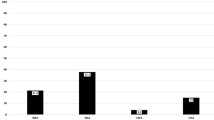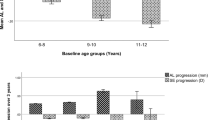Abstract
This study aimed to determine the progression pattern of non-amblyopic anisomyopic children from ages 6 to 16 years. This retrospective study analyzed the electronic medical records of 8680 myopic children who visited Sankara Nethralaya, Chennai, India over eight years (2009 to 2017). A total of 711 records were retrieved based on inclusion criteria. In addition, 423 records out of 711 had consecutive follow-up for three years (baseline plus three follow-up visits) and were considered to determine the progression pattern. The cycloplegic sphero-cylindrical refraction was taken for analysis and converted to vector notation of M (SE), J0, and J45. Anisomyopia referred to the interocular difference of myopic SE of ≥ 1 D whereas isomyopia referred to the interocular difference of myopic SE of < 1 D. Based on the refraction of the less ametropic eye, anisomyopes were further categorized into bilateral anisometropic myopia (BAM) and unilateral anisometropic myopia (UAM). The isomyopic cohort showed a mean annual progression of -0.49 ± 0.54 D (median [IQR] -0.38 D [{-0.75}-0.00]). In BAM, the mean annual progression of the more myopic eye was -0.45 ± 0.55 D (median [IQR] -0.38 D [{-0.75}-0.00]), and the less myopic eye was -0.37 ± 0.55 D (median [IQR] -0.25 D [{-0.63}-0.00]). This difference was significant (t (212) = -2.14, p < 0.05). In UAM, the myopic eyes (-0.39 ± 0.51 D; median [IQR] -0.25 D [{-0.75}-0.00]) showed a statistically significant higher mean annual progression compared to emmetropic eyes (-0.22 ± 0.36 D; median [IQR] 0.00 D [{-0.44}-0.00]; t (96) = -3.30, p < 0.001). In terms of progression trend, in the BAM group, the rate of change of mean SE between the more myopic and the less myopic eyes were similar (-1.12 ± 1.20 D; median [IQR] -1.13 D [{-2.00}-{-0.38}] vs. -1.05 ± 1.25 D; median [IQR] -0.88 D [{-1.75}-{-0.13}]; t (138) = -0.64, p > 0.05). However, the more myopic eyes of UAM showed a higher myopic trend compared to the emmetropic eyes (-1.37 ± 1.06 D; median [IQR] -1.32 D [{-2.13}-{-0.50}] vs. -0.96 ± 1.11 D; median [IQR] -0.75 D [{-1.56}-{-0.25}]; t (61) = -2.74, p < 0.05).
Conclusion: Children with BAM and UAM eyes exhibit different progression patterns from each other. While the rate of the refractive shift in myopic eyes of UAM is similar to isomyopic eyes, BAM eyes present a slower rate of progression than isomyopic eyes.
What is Known: • The rate of change of refraction in anisomyopes is higher compared to isomyopic children. • Less myopic eyes tend to shift towards more myopia while more myopic eyes show stable refraction. | |
What is New: • The progression pattern of bilateral anisometropic myopia and unilateral anisometropic myopia differ from one another. • While the rate of the refractive shift in myopic eyes of unilateral anisometropic myopia is similar to isomyopic eyes, bilateral anisometropic myopia eyes present a slower rate of progression than isomyopic eyes. • The pattern of change in the interocular difference of anisometropia depends on the laterality (bilateral or unilateral ametropia), and degree of spherical equivalent in the more ametropic eye. |



Similar content being viewed by others
Data availability
All data underlying the results are available as part of the article and no additional source data are required.
Abbreviations
- AL:
-
Axial length
- BAM:
-
Bilateral anisometropic myopia
- D:
-
Diopter
- UAM:
-
Unilateral anisometropic myopia
- SE:
-
Spherical equivalent refraction
References
Vincent SJ, Collins MJ, Read SA, Carney LG (2014) Myopic anisometropia: Ocular characteristics and aetiological considerations. Clin Exp Optom 97(4):291–307
Pärssinen O (1990) Anisometropia and Changes in Anisometropia in School Myopia. Optom Vis Sci 67(4):256–259
Sorsby A, Leary GA, Joan Richards M (1962) The optical components in anisometropia. Vision Res 2( 1–4):43–51
Vincent SJ, Collins MJ, Read SA, Carney LG, Yap MKH (2011) Interocular symmetry in myopic anisometropia. Optom Vis Sci 88(12):1454–1462
Hu YY et al (2016) Prevalence and associations of anisometropia in children. Investig Ophthalmol Vis Sci 57(3):979–988
Yoo YC, Kim JM, Park KH, Kim CY, Kim TW (2013) Refractive errors in a rural Korean adult population: The Namil Study. Eye 27(12):1368–1375
Lee CW et al (2017) Prevalence and association of refractive anisometropia with near work habits among young schoolchildren: The evidence from a population-based study. PLoS ONE 12(3):1–15
Tong L, Chan YH, Gazzard G, Tan D, Saw SM (2006) Longitudinal study of anisometropia in Singaporean school children. Investig Ophthalmol Vis Sci 47(8):3247–3252
Dobson V, Miller JM, Clifford-Donaldson CE, Harvey EM (2008) Associations between Anisometropia, Amblyopia, and Reduced Stereoacuity in a School-Aged Population with a High Prevalence of Astigmatism. Investig Opthalmology Vis Sci 49(10):4427
Huynh SC et al (2006) Prevalence and associations of anisometropia and aniso-astigmatism in a population based sample of 6 year old children. Br J Ophthalmol 90(5):597–601
Weiss AH (2003) Unilateral high myopia: Optical components, associated factors, and visual outcomes. Br J Ophthalmol 87(8):1025–1031
Pointer JS, Gilmartin B (2004) Clinical characteristics of unilateral myopic anisometropia in a juvenile optometric practice population. Ophthalmic Physiol Opt 24(5):458–463
Zedan RH, El-Fayoumi D, Awadein A (2017) Progression of high anisometropia in children. J Pediatr Ophthalmol Strabismus 54(5):282–286
Deng L, Gwiazda JE (2012) Anisometropia in children from infancy to 15 years. Investig Ophthalmol Vis Sci 53(7):3782–3787
Pärssinen O, Kauppinen M (2017) Anisometropia of spherical equivalent and astigmatism among myopes: a 23-year follow-up study of prevalence and changes from childhood to adulthood. Acta Ophthalmol 95(5):518–524
Deng L et al (2014) Limited change in anisometropia and aniso-axial length over 13 years in myopic children enrolled in the correction of myopia evaluation trial. Investig Ophthalmol Vis Sci 55(4):2097–2105
Borchert M, Tarczy-Hornoch K, Cotter SA, Liu N, Azen SP, Varma R (2010) Anisometropia in Hispanic and African American Infants and Young Children. The Multi-Ethnic Pediatric Eye Disease Study. Ophthalmology 117(1):148-153.e1
Luong TQ et al (2020) Racial and ethnic differences in myopia progression in a large, diverse cohort of pediatric patients. Investig Ophthalmol Vis Sci 61(13):1–8
Thibos LN, Wheeler W, Horner D (1997) Power vectors: An application of fourier analysis to the description and statistical analysis of refractive error. Optom Vis Sci 74(6):367–375
Verkicharla PK, Kammari P, Das AV (2020) Myopia progression varies with age and severity of myopia. PLoS ONE 15(11):e0241759
Read SA, Collins MJ, Carney LG (2007) A review of astigmatism and its possible genesis: Invited review. Clin Exp Optom 90(1):5–19
Mutti DO et al (2007) Refractive error, axial length, and relative peripheral refractive error before and after the onset of myopia. Investig Ophthalmol Vis Sci 48(6):2510–2519
Wang W et al (2023) Prevention of myopia shift and myopia onset using 0.01% atropine in premyopic children - a prospective, randomized, double-masked, and crossover trial. Eur J Pediatr 182(6):2597–2606
Tedja MS et al (2019) IMI – Myopia genetics report. Investig Ophthalmol Vis Sci 60(3):M89–M105
Caputo R, Frosini S, Campa L, Frosini R (2001) Changes in refraction in anisomyopic patients. Strabismus 9(2):71–77
Barrett BT, Bradley A, Candy TR (2013) The relationship between anisometropia and amblyopia. Prog Retin Eye Res 36:120–158
Flitcroft I, McCullough S, Saunders K (2020) What can anisometropia tell us about eye growth? Br J Ophthalmol pp 1211–1215
Qin XJ, Margrain TH, To CH, Bromham N, Guggenheim JA (2005) Anisometropia is independently associated with both spherical and cylindrical ametropia. Investig Ophthalmol Vis Sci 46(11):4024–4031
Feng L, Candy TR, Yang Y (2012) Severe myopic anisometropia in a Chinese family. Optom Vis Sci 89(4):507–511
Nunes AF, Batista M, Monteiro P (2021) Prevalence of anisometropia in children and adolescents. F1000Research 10:1–29
Author information
Authors and Affiliations
Contributions
All authors contributed to the study’s conception and design. Material preparation, data collection, and analysis were performed by Azfira Hussain, Aparna Gopalakrishnan, and Saurav Chowdhury. The first draft of the manuscript was written by Azfira Hussain and all authors commented on previous versions of the manuscript. All authors read and approved the final manuscript.
Corresponding author
Ethics declarations
Ethics approval
This study was approved by the Institutional research committee (706-2018-P) of Sankara Nethralaya, Chennai, India and the procedures conform to the tenets of the Declaration of Helsinki.
Consent to participate and publish
As part of the hospital protocol, the written consent form was obtained from each subject prior to the comprehensive eye examination assenting to the use of their data for research purposes if any.
Competing interest
The authors have no relevant financial or non-financial interests to disclose.
Additional information
Communicated by Gregorio Milani
Publisher's Note
Springer Nature remains neutral with regard to jurisdictional claims in published maps and institutional affiliations.
Supplementary Information
Below is the link to the electronic supplementary material.
Rights and permissions
Springer Nature or its licensor (e.g. a society or other partner) holds exclusive rights to this article under a publishing agreement with the author(s) or other rightsholder(s); author self-archiving of the accepted manuscript version of this article is solely governed by the terms of such publishing agreement and applicable law.
About this article
Cite this article
Hussain, A., Gopalakrishnan, A., Chowdhury, S. et al. Progression pattern of non-amblyopic Anisomyopic eyes compared to Isomyopic eyes. Eur J Pediatr 182, 4329–4339 (2023). https://doi.org/10.1007/s00431-023-05088-9
Received:
Revised:
Accepted:
Published:
Issue Date:
DOI: https://doi.org/10.1007/s00431-023-05088-9




